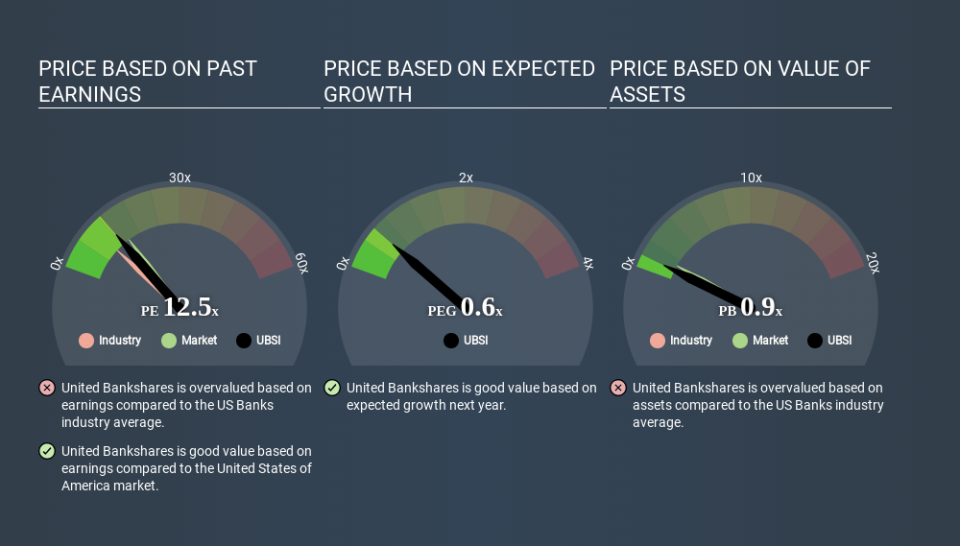What Is United Bankshares's (NASDAQ:UBSI) P/E Ratio After Its Share Price Rocketed?

United Bankshares (NASDAQ:UBSI) shareholders are no doubt pleased to see that the share price has bounced 33% in the last month alone, although it is still down 16% over the last quarter. But shareholders may not all be feeling jubilant, since the share price is still down 27% in the last year.
All else being equal, a sharp share price increase should make a stock less attractive to potential investors. While the market sentiment towards a stock is very changeable, in the long run, the share price will tend to move in the same direction as earnings per share. So some would prefer to hold off buying when there is a lot of optimism towards a stock. One way to gauge market expectations of a stock is to look at its Price to Earnings Ratio (PE Ratio). A high P/E implies that investors have high expectations of what a company can achieve compared to a company with a low P/E ratio.
Check out our latest analysis for United Bankshares
Does United Bankshares Have A Relatively High Or Low P/E For Its Industry?
United Bankshares's P/E of 12.51 indicates some degree of optimism towards the stock. You can see in the image below that the average P/E (9.8) for companies in the banks industry is lower than United Bankshares's P/E.
Its relatively high P/E ratio indicates that United Bankshares shareholders think it will perform better than other companies in its industry classification. The market is optimistic about the future, but that doesn't guarantee future growth. So further research is always essential. I often monitor director buying and selling.
How Growth Rates Impact P/E Ratios
P/E ratios primarily reflect market expectations around earnings growth rates. When earnings grow, the 'E' increases, over time. That means unless the share price increases, the P/E will reduce in a few years. Then, a lower P/E should attract more buyers, pushing the share price up.
United Bankshares shrunk earnings per share by 6.8% last year. But it has grown its earnings per share by 3.7% per year over the last five years.
A Limitation: P/E Ratios Ignore Debt and Cash In The Bank
Don't forget that the P/E ratio considers market capitalization. That means it doesn't take debt or cash into account. Hypothetically, a company could reduce its future P/E ratio by spending its cash (or taking on debt) to achieve higher earnings.
Such expenditure might be good or bad, in the long term, but the point here is that the balance sheet is not reflected by this ratio.
How Does United Bankshares's Debt Impact Its P/E Ratio?
Net debt is 45% of United Bankshares's market cap. While it's worth keeping this in mind, it isn't a worry.
The Bottom Line On United Bankshares's P/E Ratio
United Bankshares trades on a P/E ratio of 12.5, which is below the US market average of 14.4. The debt levels are not a major concern, but the lack of EPS growth is likely weighing on sentiment. What we know for sure is that investors have become more excited about United Bankshares recently, since they have pushed its P/E ratio from 9.4 to 12.5 over the last month. For those who prefer to invest with the flow of momentum, that might mean it's time to put the stock on a watchlist, or research it. But the contrarian may see it as a missed opportunity.
Investors should be looking to buy stocks that the market is wrong about. As value investor Benjamin Graham famously said, 'In the short run, the market is a voting machine but in the long run, it is a weighing machine. So this free report on the analyst consensus forecasts could help you make a master move on this stock.
Of course, you might find a fantastic investment by looking at a few good candidates. So take a peek at this free list of companies with modest (or no) debt, trading on a P/E below 20.
If you spot an error that warrants correction, please contact the editor at editorial-team@simplywallst.com. This article by Simply Wall St is general in nature. It does not constitute a recommendation to buy or sell any stock, and does not take account of your objectives, or your financial situation. Simply Wall St has no position in the stocks mentioned.
We aim to bring you long-term focused research analysis driven by fundamental data. Note that our analysis may not factor in the latest price-sensitive company announcements or qualitative material. Thank you for reading.

 Yahoo Finance
Yahoo Finance 
